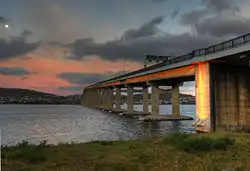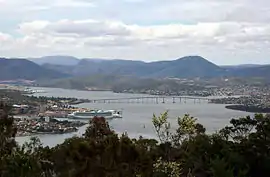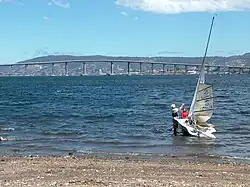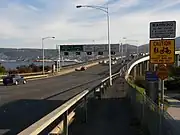Tasman Bridge | |
|---|---|
 | |
| Coordinates | 42°51′54″S 147°20′33″E / 42.86500°S 147.34250°E |
| Carries | Tasman Highway |
| Crosses | River Derwent |
| Locale | Hobart, Tasmania, Australia |
| Maintained by | Department of State Growth |
| Characteristics | |
| Design | Prestressed concrete Girder |
| Total length | 1,395 metres (4,577 ft) |
| Width | 17.5 metres (57 ft) |
| Height | 60.5 metres (198 ft) |
| Longest span | 95 metres (312 ft) |
| Clearance below | 46 metres (151 ft) |
| No. of lanes | 5 |
| History | |
| Constructed by | Reed & Mallik |
| Fabrication by | Braithwaite & Co. |
| Construction start | May 1960 |
| Construction end | 23 December 1964 |
| Opened | 18 August 1964 (2 lanes) 23 December 1964 (4 lanes) 18 March 1965 (official) |
| Statistics | |
| Daily traffic | 73,029 (May 2019)[1] |
| Location | |
The Tasman Bridge is a bridge that carries the Tasman Highway over the River Derwent in Hobart, Tasmania, Australia. Including approaches, the bridge has a total length of 1,396 metres (4,580 ft) and it provides the main traffic route from the Hobart city centre (on the western shore) to the eastern shore. The bridge has a separated pedestrian footway on each side. There is no dedicated lane for bicycles; however, steps to the pedestrian footway were replaced with ramps in 2010.[2]
History

Throughout the 1950s, Hobart's eastern shore experienced significant growth due to the establishment of the Hobart International Airport at Cambridge in 1956. As air travel and car usage became widespread, traffic increased, surpassing the capabilities of the existing Hobart Bridge, whose single carriageway struggled to cope with the escalating traffic volumes and significant disruptions caused by raising of the bridge's lift span for passing ships. These challenges highlighted the pressing need for a new, more accommodating bridge designed specifically for the increased traffic flow without constant interruptions for maritime navigation.
Design
In 1956, Tasmania's Department of Public Works commissioned Maunsell & Partners Pty Ltd to design the new River Derwent crossing. The engineers recommended a bridge supported by multiple piers due to the width of the water expanse, similar to that of the Sydney Harbour Bridge but requiring a comparable height to accommodate medium-sized cargo vessels. Consequently, a decision was made to construct a bridge featuring nineteen spans, including a navigation span at its apex, with 13 spans to the west and 6 spans to the east, each measuring 42.7 meters (140 ft) wide. The increased number of interval spans were critical in the design due to the height required for the apex and weight of the concrete required.
Criticism of then-Premier Eric Reece arose in 1958 when concerns were raised by engineers about the susceptibility of the concrete design to potential ship collisions. Investigative reports revealed Reece's dismissal of objections during parliamentary proceedings in favor of the $14 million project over a slightly more expensive suspension bridge option.[3]
Construction
_(16198893025).jpg.webp)
Tenders were issued in April 1959, and contracts were subsequently awarded to Reed, Braithwaite, Stuart, and Lipscombe in November of the same year.[4] Construction commenced in May 1960.
Several prerequisites were crucial during construction. The old Hobart Bridge had to remain operational until the Tasman Bridge's completion, and shipping lanes along the River Derwent needed to stay open. The favorable conditions of the riverbed, consisting of bedrock, dolerite, and basalt beneath the silt, provided stability for the bridge's foundations.
The construction posed significant challenges for Hobart as it marked the city's largest and most expensive undertaking to date. Procuring construction equipment, such as jacks and wires, required sourcing from the UK, while reinforced steel had to be imported from the Australian mainland, contributing to the bridge's elevated cost, totaling £7 million, equivalent to $14 million in 2015.
The first two lanes bridge opened on 18 August 1964.[5][6] The other two lanes opened on 23 December 1964. It was officially opened on 18 March 1965 by Prince Henry, Duke of Gloucester.
Disaster
On 5 January 1975, the Tasman Bridge was struck by the bulk ore carrier Lake Illawarra, bound for EZ Industries' Risdon Zinc Works with a cargo of 9,072 tonnes (10,000 short tons) of zinc concentrate.[7] It caused two pylons and three sections of concrete decking, totalling 127 metres (417 ft), to fall from the bridge and sink the ship. Seven of the ship's crew were killed, and five motorists died when four cars drove over the collapsed sections before the traffic was stopped. A major press shot showed a Holden Monaro HQ and Holden EK perched balancing on the ledge.[8]
The depth of the river at this point is 35 metres (115 ft). The wreck of Lake Illawarra still lies on the bottom, with concrete slab on top of it, without presenting a navigation hazard to smaller vessels.
The breakage of an important arterial link isolated the residents in Hobart's eastern suburbs – the relatively short drive across the Tasman Bridge to the city suddenly became a 50-kilometre (31 mi) journey via the estuary's next bridge at Bridgewater. The only other vehicular crossing within Hobart after the bridge collapsed was the Risdon Punt, a cable ferry which crossed the river from East Risdon and Risdon, some five kilometres (3.1 mi) upstream from the bridge. It was totally inadequate, carrying only eight cars on each crossing, and although ferries provided a service across the river; it was not until December 1975 that a two lane, 788-metre-long (2,585 ft) bailey bridge was opened to traffic, two kilometres (1.2 mi) to the north from Dowsing Point to Cleburne Point thereby restoring some connectivity.[9] The bailey bridge remained in use until replaced by the Bowen Bridge in 1984.[10]
The separation of Hobart saw an immediate surge in the small and limited ferry service then operating across the river.[7] In a primary position to provide a service were the two ferries of Bob Clifford. He had introduced the locally-built ferries Matthew Brady and James McCabe to the river crossing, from the Hobart city centre to the eastern shore, shortly before the collision. These were soon joined by the MV Cartela, a wooden vessel of 1912 vintage, and Kosciusko, Lady Ferguson and Lady Wakehurst that were loaned by the New South Wales Public Transport Commission.[11][12]
Following the Tasman Bridge Disaster, former-Premier Eric Reece maintained his defence of the chosen bridge design. Reece argued that the selected design was the sole financially viable option for the state at that time, despite the construction costs doubling throughout the project's execution.[3]
Reconstruction
Reconstruction of the Tasman Bridge by John Holland commenced in October 1975. An important factor of the reconstruction is the improved safety measures. Some examples:
- Large vessels passing beneath the bridge must now do so slightly to the west of the original main navigation span.
- Personnel controlling ships (or harbor pilots) must be trained and then cleared for using the special laser lighthouse that indicates by colours whether the ship must be steered left or right to regain the centre line.
- All road traffic is now halted whilst large vessels transit beneath the bridge.
On top of the new safety measures implemented, the bridge was further upgraded to hold a fifth lane.[7][13][14] This upgrade included the construction of a lane management system which would enable the new middle lane to function as a reversible lane. The system consists of a traffic light system and a sign above each lane, pictured right. The signs, in conjunction with the traffic light system, employ a pulley system to periodically pull the signs over their appropriate lanes.
The middle lane points towards the city side (or western shore) during a.m. peak hours and points back towards the eastern shore during p.m. peak hours. The lane generally points towards the eastern shore during non-peak hours.
The Tasman Bridge repair took two years and cost approximately $44 million.[13] The bridge reopened on 8 October 1977.[7][13][15]
On 20 June 2007, a crane toppled whilst carrying out works on the bridge, and precariously hung for a number of hours off the side of the barriers.[16]
LED upgrade

In 2019 the Hobart City Council commissioned Decrolux to convert the Tasman bridge's fluorescent lighting with modern LED lighting. Spanning almost 3 kilometres (1.9 mi) and utilising 1,930 LEDs, the project was completed in 2021. The lights are remotely programmable and have been used to celebrate Dark Mofo and the Hobart Hurricanes, as well as to show support for causes including Women's Health Week and Men's Health Week.[17]
Gallery
 View of the bridge from the eastern shore
View of the bridge from the eastern shore Looking towards the Tasman Bridge from Montagu Bay
Looking towards the Tasman Bridge from Montagu Bay Dinghy and the bridge.
Dinghy and the bridge. The repaired bridge span
The repaired bridge span The view of the Bridge from Mount Wellington
The view of the Bridge from Mount Wellington A view of the bridge from the river
A view of the bridge from the river Tasman Bridge from the Western shore
Tasman Bridge from the Western shore Entering the bridge from the eastern shore
Entering the bridge from the eastern shore.jpg.webp) Entering the bridge from the west side
Entering the bridge from the west side
See also
References
- ↑ Department of State Growth (2019). Department of State Growth Key Arterials Traffic Data Catalogue (PDF). Retrieved 16 August 2022.
- ↑ "Cycling South Tasmania – Tasman Hwy and Bridge". 2010. Archived from the original on 29 September 2020. Retrieved 18 July 2013.
- 1 2 Stephens, Tom (1880), "Labor's Bridge of Sighs", The Bulletin, John Ryan Comic Collection (Specific issues)., Sydney, N.S.W: John Haynes and J.F. Archibald, p. 12, ISSN 0007-4039, nla.obj-1440175956, retrieved 21 November 2023 – via Trove
- ↑ "New £4m. Bridge For Derwent". The Canberra Times. Vol. 34, no. 9, 459. Australian Capital Territory, Australia. 28 November 1959. p. 3. Retrieved 28 November 2023 – via National Library of Australia.
- ↑ Giant Bridge Opened Truck & Bus Transportation September 1964 page 109
- ↑ Tasman Bridge Australian Transport October 1964 page 27
- 1 2 3 4 "Tasmanian Year Book, 2000". Australian Bureau of Statistics. 2002. Retrieved 22 February 2008.
- ↑ "Bridge gone". Tasmanian Government. 2000. Archived from the original on 12 April 2020. Retrieved 22 February 2008.
- ↑ Hobart's Temporary Bridge Australian Transport April 1976 pages 34/35
- ↑ Hobart Electric Traction May 1984 page 93
- ↑ New terminals for ferries on three weeks Canberra Times 11 January 1975 page 1
- ↑ A Friend in Need Transport News March 1975 page 3
- 1 2 3 "Tasman Bridge disaster". Clarence City Council. 2004. Archived from the original on 4 March 2016. Retrieved 22 February 2008.
- ↑ "Tasman Bridge Disaster - City of Clarence : City of Clarence". Clarence City Council. Archived from the original on 16 August 2022. Retrieved 16 August 2022.
- ↑ The Roads Australian Transport October 1978 page 6
- ↑ "Crane drama on Tasman Bridge". The Mercury. 21 June 2007. Archived from the original on 26 June 2007. Retrieved 22 February 2008.
- ↑ "Tasman Bridge Lighting Upgrade". decrolux.com.au. Retrieved 8 March 2023.
- Reference: Lewis, Tom. By Derwent Divided. Darwin: Tall Stories, 1999.
- Ludeke, M. (2006) Ten Events Shaping Tasmania's History. Hobart: Ludeke Publishing.
External links
![]() Media related to Tasman Bridge at Wikimedia Commons
Media related to Tasman Bridge at Wikimedia Commons
- Live webcam view of Hobart including the Tasman Bridge
- Traffic camera view of the Tasman Bridge
- Archival photographs of construction of the Tasman Bridge: page 1, page 2.
- 1995 article about Tasman Bridge safety
- Hobart To Tasman Bridge 1938–2000
- Tasman Bridge at Structurae
